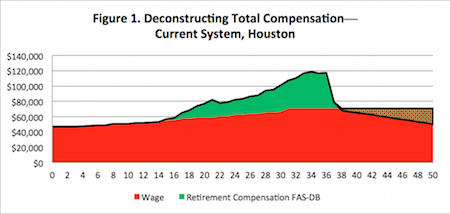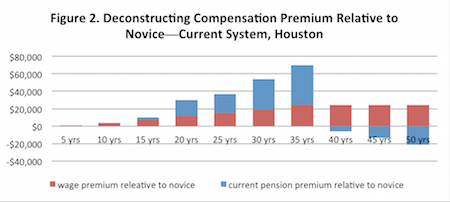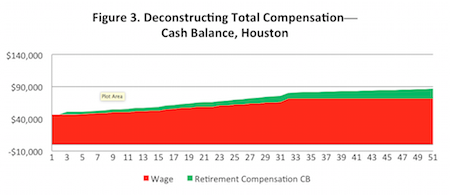Extensive empirical research shows that improvements to teacher quality occur mainly in the first several years in the classroom. Academics and education reformers have long pointed to this data to argue that teacher pay should depend less heavily on experience. For instance, writing in Education Next, economist Jake Vigdor showed that teacher take-home salaries are more heavily backloaded late into one’s career than is the case for other professionals, despite little evidence that more experienced teachers were more effective in the classroom. In a new paper for the Manhattan Institute, we demonstrate that school districts pay even more for experience than previously thought.
Deferred retirement benefits make up a large portion of teachers’ total compensation, especially later in their careers; yet standard analyses typically consider only the link between teachers’ current pay and experience. Using data from each of the ten largest U.S. public school districts, our paper accounts for retirement compensation to calculate the true teacher experience premium.
Figure 1 illustrates total compensation from salary and deferred retirement benefits for each year of a 25-year-old teaching entrant’s employment in the Houston Independent School District (HISD). Areas in the figure are cumulative: red represents salary according to the district’s salary schedule; green represents retirement benefits earned by the teacher in that year, net of his contributions (i.e., retirement compensation); and total compensation is the sum of the two areas. At 20 years of service, the same Houston teacher would earn a salary of $58,906 (red) and a retirement compensation of $18,152 (green), for a total compensation of $77,058.

Early in a HISD teacher’s career, rising compensation comes entirely from progression up the salary ladder—as is common across the U.S., HISD teachers do not vest into the pension plan for ten years and do not become eligible for meaningful retirement compensation for years after. However, once a teacher reaches his second and third decade of teaching (i.e. 20 years in the classroom), annual retirement compensation rises rapidly. HISD teachers in year 33 earn $70,941 in salary, as well as $46,101 in retirement benefits.
Late in a teacher’s career, in Houston, as elsewhere, retirement compensation turns negative, reducing total compensation (checkered area in Figure 1). Under HISD’s benefits tier for new teachers, this occurs after about year 40. Teachers’ retirement benefits become a drag on total compensation when the increase in benefits for an additional year worked is less than the amount lost from the lost year of collecting a pension during retirement. When this point is reached, the teacher-experience premium declines.
In many districts, the most experienced teachers (those who teach beyond the system’s “normal” retirement age) thus teach for pennies on the dollar. In Nevada’s Clark County, teachers with more than 30 years of experience actually earn substantially less total compensation than a novice teacher: the loss in retirement payments for such a teacher who remains employed another year is more than the difference between his salary and that of a newly hired teacher.
For all but the most experienced teachers, backloading teachers’ pensions substantially increases the compensation of experienced teachers relative to younger teachers. Figure 2—which illustrates the compensation division between salary and pension in five-year increments—reveals the extent to which differences in total compensation earned by HISD teachers with varying experience compares with that of novice teachers.

Figure 2 shows how the premium paid for experience early in teachers’ careers is primarily due to salary differences. But as teachers advance in their careers, retirement compensation plays a much larger role. Beginning in year 20, deferred retirement benefits for HISD teachers become a significant share of the total compensation teacher-experience premium: a teacher in year 35 earns $24,004 more in salary than a novice teacher ($70,941 v. $46,936) and $45,846 more than the retirement compensation ($0) received by a not-yet-vested novice teacher.
Because the current backloaded system provides greater retirement compensation for older teachers by decreasing the retirement compensation of younger teachers, paying a large premium for experience may not be the most equitable way to compensate teachers. Alternative retirement models, such as cash balance (CB) plans, would allow teachers to earn a secure retirement benefit over the course of their career while also reducing the large late-career experience premium most current plans exhibit. Under a CB plan, for example, annual retirement compensation is a fixed percentage of teachers’ salaries, and so retirement compensation is earned more evenly across their years in the classroom.
In our Manhattan Institute paper, we model CB plans that are cost-equivalent with current retirement systems in the ten largest U.S. school districts. These CB plans offer entering teachers the same expected retirement compensation as existing plans, with the same expected cost for taxpayers. Figure 3 deconstructs total compensation for a representative HISD teacher under a cost-equivalent CB plan. Unlike current backloaded plans, teachers earn meaningful retirement benefits each year under the CB plan. Further, the CB plan does not redistribute retirement compensation away from teachers who leave after, say, five, ten, or 15 years to teachers who work under the same plan their entire careers, an effect that in many systems would likely help more people reach retirement security.

In previous work, we demonstrated that because most teachers are somewhat risk averse and likely will not work under a single retirement plan for their entire careers, entering teachers should strongly prefer earning retirement benefits more evenly than they do under current backloaded plans. As mentioned, the CB plan we model is a defined-benefit plan that maintains the same investment and longevity protections that teachers currently enjoy. The CB plan simply distributes retirement compensation more evenly across teachers’ careers—increasing retirement compensation for younger teachers, reducing the current large experience premium, and eliminating the penalty imposed on those who teach beyond the standard, arbitrary retirement age.
To date, analysis of teacher compensation and classroom performance has all but ignored retirement compensation. Our paper documents the importance of this omission, and suggests a way to make teacher compensation more fair for more teachers.
— Josh B. McGee and Marcus A. Winters
Josh B. McGee is a senior fellow at the Manhattan Institute and a vice president at the Laura and John Arnold Foundation. Marcus A. Winters is a Manhattan Institute senior fellow and an assistant professor at the University of Colorado Colorado Springs.


